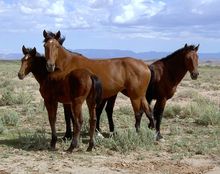Private Commercial Livestock Special Interests Dominate Gov’t Advisory Board as They Target Wild Horses for Range Damage Caused By Private Livestock
The American Wild Horse Preservation Campaign (AWHPC), a national coalition, and its founding organization, Return to Freedom, responded strongly to the Bureau of Land Management’s (BLM’s) National Wild Horse and Burro Advisory Board recommendation that the agency focus on range damage caused by wild horses instead of the damage caused by private livestock, which dominate western public lands.

Wild horses on open range
BLM Called Upon to Protect Range and Federally-Protected Wild Horses: Remove All Livestock During Extreme Drought.
© 2014 by Kersti Nebelsiek
The recommendation was made today at the end of a two-day meeting of the Advisory Board in Sacramento, CA.
Despite three years of drought and the worst drought on record hitting western states, the BLM continues to allow private livestock to graze on public lands where wild horses are facing extreme range conditions.
“The BLM Advisory Board is dominated by ranching interests that are scapegoating wild horses for range damage caused by private livestock, which outnumber wild horses by at least 50 to 1 on our western public lands,” said Deniz Bolbol, AWHPC spokesperson. “We call upon the BLM to immediately close wild horse and burro habitat areas to livestock grazing and to develop a comprehensive program, including water hauling, to secure water sources to prevent suffering of these federally-protected animals in the upcoming summer months.”
"Wild horses are fenced in, fenced out, forced to live under unnatural conditions and given the scraps of forage in designated habitat areas after BLM has allocated the vast majority to livestock,” said Neda DeMayo, founder and president of Return to Freedom (RTF), AWHPC’s founding organization. “They’re being set up for crisis by BLM’s failure to require reductions to or elimination of livestock grazing in designated wild horse and burro habitat areas. National polls demonstrate that Americans strongly support protecting wild horses on public lands. It’s time for the BLM to start managing the public lands in the interests of all Americans.”
DeMayo noted that federal regulation authorizes the BLM to reduce or eliminate livestock grazing in order to make forage available to wild horses and burros in designated HMAs.
According to AWHPC and RTF, ranchers view wild horses as competition for cheap, tax-subsidized grazing on public land. But polls show that the overwhelming majority of Americans support protecting wild horses and burros on public lands. By contrast, just 29 percent of Americans want our public lands used for livestock grazing.
AWHPC and RTF also charged the BLM with failing to use available fertility control and forcing a crisis that could lead to the slaughter of wild horses. In doing so, the BLM is ignoring the June 2013 findings of the National Academy of Sciences (NAS) review of the federal wild horse and burro program. The NAS found that:
· “Removals are likely to keep the population at a size that maximizes population growth rate, which in turn maximizes the number of animals that must be removed and processed through holding facilities.” (P. 94)
· “Tools [including PZP fertility control] already exist for BLM to address many challenges.” (p. 13) (P. 303 confirms that BLM is not using PZP in a manner that will impact population growth.)
· “… addressing the problem immediately with a long-term view is probably a more affordable option than continuing to remove horses to long-term holding facilities. (p. 13-14)
AWHPC and RTF also took issue with BLM’s statements that there are more wild horses out there than the range can withstand, pointing to the NAS finding that the BLM estimates for the “appropriate” number of wild horses for the range had no basis in science:
· "The committee could not identify a science-based rationale used by BLM to allocate forage and habitat resources to various uses within the constraints of protecting rangeland health and listed species and given the multiple-use mandate.” (p. 303)
· “How Appropriate Management Levels (AMLs) are established, monitored, and adjusted is not transparent to stakeholders, supported by scientific information, or amenable to adaptation with new information and environmental and social change. Standards for transparency, quality and equity are needed in establishing these levels, monitoring them and adjusting them.” (p. 12)
Within designated HMAs, the BLM allocates over 82 percent of forage to privately-owned livestock and less than 18 percent of forage to federally-protected wild horses.
The American Wild Horse Preservation Campaign (AWHPC) is a coalition of more than 60 horse advocacy, public interest, and conservation organizations dedicated to preserving the American wild horse in viable, free-roaming herds for generations to come, as part of our national heritage.
